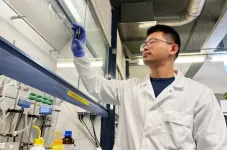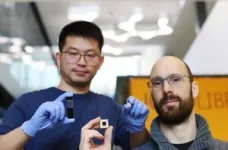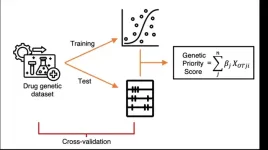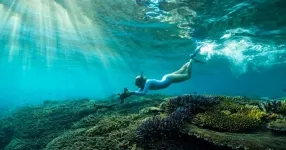Invisible to our eyes, shortwave infrared (SWIR) light can enable unprecedented reliability, function and performance in high-volume, computer vision first applications in service robotics, automotive and consumer electronics markets. Image sensors with SWIR sensitivity can operate reliably under adverse conditions such as bright sunlight, fog, haze and smoke. Furthermore, the SWIR range provides eye-safe illumination sources and opens up the possibility of detecting material properties through molecular imaging.
Colloidal quantum dots (CQD) based image sensor technology offers a promising technology platform to enable high-volume compatible image sensors in the SWIR. CQDs, nanometric semiconductor crystals, are a solution-processed material platform that can be integrated with CMOS and enables accessing the SWIR range. However, a fundamental roadblock exists in translating SWIR-sensitive quantum dots into key enabling technology for mass-market applications, as they often contain heavy metals like lead or mercury (IV-VI Pb, Hg-chalcogenide semiconductors). These materials are subject to regulations by the Restriction of Hazardous Substances (RoHS), a European directive that regulates their use in commercial consumer electronic applications.
In a new study published in Nature Photonics, ICFO researchers Yongjie Wang, Lucheng Peng, and Aditya Malla led by ICREA Prof. at ICFO Gerasimos Konstantatos, in collaboration with researchers Julien Schreier, Yu Bi, Andres Black, and Stijn Goossens, from Qurv, have reported on the development of high-performance infrared photodetectors and a shortwave infrared (SWIR) image sensor operating at room temperature based on non-toxic colloidal quantum dots. The study describes a new method for synthesizing size tuneable, phosphine-free silver telluride (Ag2Te) quantum dots while preserving the advantageous properties of traditional heavy-metal counterparts paving the way to the introduction of SWIR colloidal quantum dot technology in high-volume markets.
While investigating how to synthetize silver bismuth telluride (AgBiTe2) nanocrystals to extent the spectral coverage of the AsBiS2 technology to enhance the performance of photovoltaic devices, the researchers obtained silver telluride (Ag2Te) as a by-product. This material showed a strong and tuneable quantum confined absorption akin to quantum dots. They realized its potential for SWIR photodetectors and image sensors and pivoted their efforts to achieve and control a new process to synthesize phosphine-free versions of silver telluride quantum dots, as phosphine was found to have a detrimental impact on the optoelectronic properties of the quantum dots relevant to photodetection.
In their new synthetic method, the team used different phosphine-free complexes such as a tellurium and silver precursors that led them to obtain quantum dots with a well-controlled size distribution and excitonic peaks over a very broad range of the spectrum. After fabricating and characterizing them, the new synthesized quantum dots exhibited remarkable performances, with distinct excitonic peaks over 1500 nm—an unprecedented achievement compared to previous phosphine-based techniques for quantum dot fabrication.
The researchers decided then to implement the obtained phosphine-free quantum dots to fabricate a simple laboratory scale photodetector on the common standard ITO (Indium Tin Oxide)-coated glass substrate to characterize the devices and measure its properties. “Those lab-scale devices are operated with shining light from the bottom. For CMOS integrated CQD stacks, light comes from the top, whereas the bottom part of the device is taken by the CMOS electronics”, comments Yongjie Wang, postdoc researcher at ICFO and first author of the study. “So, the first challenge we had to overcome was reverting the device setup. A process that in theory sounds simple, but in reality proved to be a challenging task”.
Initially, the photodiode exhibited a low performance in sensing SWIR light, prompting a redesign that incorporated a buffer layer. This adjustment significantly enhanced the photodetector performance, resulting in a SWIR photodiode exhibiting a spectral range from 350nm to 1600nm, a linear dynamic range exceeding 118 dB, a -3dB bandwidth surpassing 110 kHz and a room temperature detectivity of the order 1012 Jones.
"To the best of our knowledge, the photodiodes reported here have for the first time realized solution processed, non-toxic shortwave infrared photodiodes with figures of merit on par with other heavy-metal containing counterparts", Gerasimos Konstantatos, ICREA Prof. at ICFO and leading author of the study mentions. "These results further support the fact that Ag2Te quantum dots emerge as a promising RoHS-compliant material for low-cost, high-performance SWIR photodetectors applications".
With the successful development of this heavy-metal-free quantum dot based photodetector, the researchers went further and teamed up with Qurv, an ICFO spin-off, to demonstrate its potential by constructing a SWIR image sensor as a case study. The team integrated the new photodiode with a CMOS based read-out integrated circuit (ROIC) focal plane array (FPA) demonstrating for the first time a proof-of-concept, non-toxic, room temperature-operating SWIR quantum dot based image sensor. The authors of the study tested the imager to prove its operation in the SWIR by taking several pictures of a target object. In particular, they were able to image the transmission of silicon wafers under the SWIR light as well as to visualize the content of plastic bottles that were opaque in the visible light range.
“Accessing the SWIR with a low-cost technology for consumer electronics will unleash the potential of this spectral range with a huge range of applications including improved vision systems for automotive industry (cars) enabling vision and driving under adverse weather conditions”, says Gerasimos Konstantatos. “SWIR band around 1.35-1.40 µm, can provide an eye-safe window, free of background light under day/night condition, thus, further enable long-range light detection and ranging (LiDAR), three-dimensional imaging for automotive, augmented reality and virtual reality applications”.
Now the researchers want to increase the performance of photodiodes by engineering the stack of layers that comprise the photodetector device. They also want to explore new surface chemistries for the Ag2Te quantum dots to improve the performance and the thermal and environmental stability of the material on its way to the market.
Original article
Wang, Y., Lucheng, P. Schreier, J., Bi, Y. Black, A., Malla, A. Goossens, S., Konstantatos, G. (2023) Silver telluride colloidal quantum dot infrared photodetectors and image sensors. Nature Photonics. doi: https://www.nature.com/articles/s41566-023-01345-3
Link to the YouTube video
END









